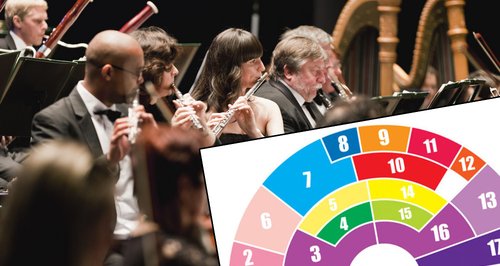Warum hauen nur Männer auf die Pauke?
Auch im Konzertsaal herrscht noch keine Geschlechtergerechtigkeit.
Von: VOLKER WEINL, Bild
In deutschen Orchestern geben meistens Männer den Ton an. Das ergab eine Befragung des Deutschen Musikinformationszentrums unter 129 Berufsorchestern in Deutschland.
Insgesamt wirken 60 Prozent Männer und 40 Prozent Frauen zwar halbwegs ausgeglichen. Weniger harmonisch wirkt das Geschlechterverhältnis, wenn man sich die in der Rangordnung am höchsten stehenden und am besten bezahlten Positionen anschaut: Bei den sogenannten Stimmführern und Solisten (Zuschlag bis zu 876,70 Euro) beträgt der Männeranteil 74 Prozent. Auch eindrucksvoll: Frauen spielen zwar 61 Prozent aller Violinen. Der Konzertmeister aber – die wichtigste Geige im Orchester – ist in 70 Prozent der Fälle männlich. Nur den Konzertmeister begrüßt der Dirigent per Handschlag.
Frauen sind auf dem Vormarsch, heißt es. So passt es ins Bild, wenn das Statistische Bundesamt aktuell mitteilt
Und der Dirigent? Ist praktisch immer ein Mann! „Aktuell gibt es in 129 Orchestern nur drei Chefdirigentinnen“, sagt Anke Steinbeck (42) vom Deutschen Musikrat. „Im Orchesterbetrieb gilt leider noch immer: Wo Macht, Renommee und Geld zusammenkommen, dominieren die Männer.“
Orchester-Musikerinnen waren früher die Ausnahme
Auch am Klischee von typisch männlich und typisch weiblichen Instrumenten ist was dran. Pauke: 95 Prozent Männer. Harfe: 94 Prozent Frauen. Warum? Die Gründe sind vor allem historisch. „Anfang der 1960er-Jahre waren Frauen in professionellen Orchestern noch die absolute Ausnahme“, sagt Gerald Mertens (63) von der Deutschen Orchestervereinigung. „Waren überhaupt Frauen dabei, spielten sie vorrangig Harfe.“ Bei den Berliner Philharmonikern gab es noch bis 1982 ausschließlich Männer.
Die wichtigsten Orchester-Instrumente – und wer sie spielt:
98 Prozent beträgt der Männer-Anteil bei der TUBA
97 Prozent der Musiker mit POSAUNE sind Männer
95 Prozent der Orchester-PAUKISTEN sind Männer
94 Prozent beträgt der Frauen-Anteil bei der HARFE
85 Prozent ist die Männerquote beim KONTRABASS
66 Prozent der VIOLINISTEN sind Frauen.
An den körperlichen Voraussetzungen liegt es nicht, dass Frauen selten „Männerinstrumente“ wie Tuba, Posaune oder Kontrabass spielen. Mertens: „Es kann einfach Jahrzehnte dauern, bis sich Rollenmodelle ändern. Unterrichtet aber an einer Musikschule endlich eine Kontrabassistin, wirkt diese dann auch als Vorbild für junge Mädchen.“
Doch Mertens glaubt an eine weiblichere Orchester-Zukunft: „Junge Mädchen und Frauen legen im Vergleich zu jungen Männern offenbar eine höhere Übe-Disziplin an den Tag. Daher vermuten wir, dass sie in nicht allzu ferner Zeit auch verstärkt Solopositionen besetzen werden.“
.jpg)



